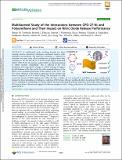Files in this item
Multifaceted study of the interactions between CPO-27-Ni and polyurethane and their impact on nitric oxide release performance
Item metadata
| dc.contributor.author | Vornholt, Simon M | |
| dc.contributor.author | Duncan, Morven J | |
| dc.contributor.author | Warrender, Stewart J | |
| dc.contributor.author | Semino, Rocio | |
| dc.contributor.author | Ramsahye, Naseem A | |
| dc.contributor.author | Maurin, Guillaume | |
| dc.contributor.author | Smith, Martin W | |
| dc.contributor.author | Tan, Jin-Chong | |
| dc.contributor.author | Miller, David N | |
| dc.contributor.author | Morris, Russell E | |
| dc.date.accessioned | 2021-01-04T13:30:07Z | |
| dc.date.available | 2021-01-04T13:30:07Z | |
| dc.date.issued | 2020-12-30 | |
| dc.identifier | 271749233 | |
| dc.identifier | 1e6b7475-47a5-45a1-bae1-81a2efe384d9 | |
| dc.identifier | 33325239 | |
| dc.identifier | 000605187100056 | |
| dc.identifier | 85098793755 | |
| dc.identifier.citation | Vornholt , S M , Duncan , M J , Warrender , S J , Semino , R , Ramsahye , N A , Maurin , G , Smith , M W , Tan , J-C , Miller , D N & Morris , R E 2020 , ' Multifaceted study of the interactions between CPO-27-Ni and polyurethane and their impact on nitric oxide release performance ' , ACS Applied Materials & Interfaces , vol. 12 , no. 52 , pp. 58263-58276 . https://doi.org/10.1021/acsami.0c17937 | en |
| dc.identifier.issn | 1944-8244 | |
| dc.identifier.other | ORCID: /0000-0001-7809-0315/work/85566215 | |
| dc.identifier.uri | https://hdl.handle.net/10023/21216 | |
| dc.description | S.M.V. would like to thank the EPSRC for funding opportunities under grant agreement EP/K005499/1. S.M.V. and D.N.M. would further like to acknowledge the EPSRC Capital for Great Technologies grant (EP/L017008/1) and the EPSRC Strategic Equipment Resource grant (EP/R023751) for funding and supporting electron microscopy facilities at the University of St Andrews. M.J.D. and S.J.W. would like to acknowledge the ProDIA project that has received funding from the European Union’s Horizon 2020 research and innovation programme under grant agreement no. 685727. | en |
| dc.description.abstract | A multifaceted study involving focused ion beam scanning electron microscopy techniques, mechanical analysis, water adsorption measurements, and molecular simulations is employed to rationalize the nitric oxide release performance of polyurethane films containing 5, 10, 20, and 40 wt % of the metal-organic framework (MOF) CPO-27-Ni. The polymer and the MOF are first demonstrated to exhibit excellent compatibility. This is reflected in the even distribution and encapsulation of large wt % MOF loadings throughout the full thickness of the films and by the rather minimal influence of the MOF on the mechanical properties of the polymer at low wt %. The NO release efficiency of the MOF is attenuated by the polymer and found to depend on wt % of MOF loading. The formation of a fully connected network of MOF agglomerates within the films at higher wt % is proposed to contribute to a more complex guest transport in these formulations, resulting in a reduction of NO release efficiency and film ductility. An optimum MOF loading of 10 wt % is identified for maximizing NO release without adversely impacting the polymer properties. Bactericidal efficacy of released NO from the films is demonstrated against Pseudomonas aeruginosa, with a >8 log10 reduction in cell density observed after a contact period of 24 h. | |
| dc.format.extent | 8045513 | |
| dc.language.iso | eng | |
| dc.relation.ispartof | ACS Applied Materials & Interfaces | en |
| dc.subject | Organic polymers | en |
| dc.subject | Metal-organic frameworks | en |
| dc.subject | Polymers | en |
| dc.subject | Mixed-matrix membranes | en |
| dc.subject | Composite materials | en |
| dc.subject | FIB-SEM | en |
| dc.subject | Nitric oxide | en |
| dc.subject | Medical applications | en |
| dc.subject | QD Chemistry | en |
| dc.subject | DAS | en |
| dc.subject.lcc | QD | en |
| dc.title | Multifaceted study of the interactions between CPO-27-Ni and polyurethane and their impact on nitric oxide release performance | en |
| dc.type | Journal article | en |
| dc.contributor.sponsor | EPSRC | en |
| dc.contributor.sponsor | EPSRC | en |
| dc.contributor.sponsor | European Research Council | en |
| dc.contributor.sponsor | EPSRC | en |
| dc.contributor.sponsor | European Commission | en |
| dc.contributor.institution | University of St Andrews. School of Chemistry | en |
| dc.identifier.doi | https://doi.org/10.1021/acsami.0c17937 | |
| dc.description.status | Peer reviewed | en |
| dc.identifier.grantnumber | EP/K005499/1 | en |
| dc.identifier.grantnumber | EP/R023751/1 | en |
| dc.identifier.grantnumber | 787073 | en |
| dc.identifier.grantnumber | EP/K025112/1 | en |
| dc.identifier.grantnumber | 685727 | en |
This item appears in the following Collection(s)
Items in the St Andrews Research Repository are protected by copyright, with all rights reserved, unless otherwise indicated.

